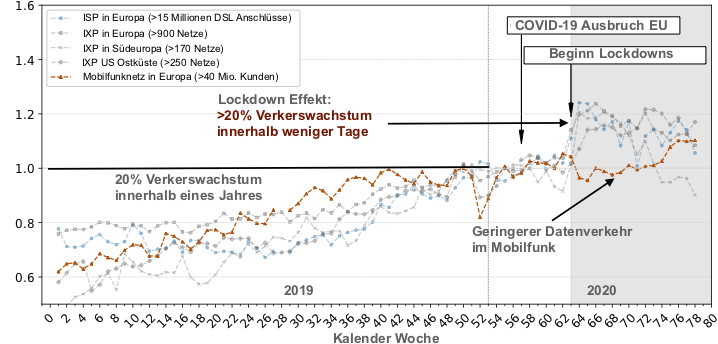How long will the Internet Corona last?
Online teaching, the home office, video calls with relatives - nothing works without the Internet. But what happens to the "network of networks" when suddenly the whole world changes its behavior almost simultaneously? When services that were previously only sparsely used suddenly experience an order of magnitude increase in demand? It stands to reason that from the very beginning there were fears that this immense load would not remain without massive disruptions and outages. But as the study now available shows: the Internet infrastructure - optical fibers, submarine cables, satellite links and, above all, the countless nodes between the connections - is generally robust and adaptable enough to withstand the pandemic. Even in the event of another "hard" lockdown.
"Only the internet has allowed us to continue our lives like this during the pandemic - the internet and Corona are a success story" says Prof. Hohlfeld of the Brandenburg University of Technology Cottbus-Senftenberg.
Internet traffic patterns are constantly growing and changing, but the speed at which this happened in the spring of 2020 due to the lockdown measures is unprecedented. So what did this mean for the Internet, and how did the networks cope with the sharp increase in traffic? Reason enough for a scientific study, conducted by an international team of researchers from BENOCS GmbH, Brandenburg University of Technology Cottbus-Senftenberg, the IMDEA Networks Institute in Madrid, the Max Planck Institute for Computer Science, the world's largest Internet hub DE-CIX, and the Universidad Carlos III de Madrid, to examine the impact of the Corona pandemic on the Internet in several countries and come to two important conclusions: Yes, there were immense changes in terms of traffic; but also: The Internet coped surprisingly well.
The researchers have succeeded for the first time in observing in several countries that the lockdown measures - as expected - also have an impact on Internet traffic. On the one hand, the composition of data traffic is changing fundamentally: video conferencing services or access to home offices (VPNs) are seeing a significant increase in traffic. The times of use are also changing: whereas the main time of use before the pandemic was during the week in the evening hours, the main time of use now also includes working hours during the day. In this respect, network usage on weekdays is now for the first time similar to that on weekends: the difference between weekday and weekend on the Internet is becoming blurred. Moreover, the researchers are observing a general increase in data traffic of 15-30% in just a few days.
This is remarkable, as network operators usually expect this to happen within a whole year, so the initial question of how well the Internet infrastructure can cope with a short-term and major change in data traffic is quite justified.
However, the study also shows that most of the networks considered are able to cope with the Corona pandemic surprisingly well and are robust. This is due to how well the network operators build out their networks and how we use them. Firstly, the increases in usage mostly take place outside the previous peak usage times (e.g. during the day in the home office) - so the volume of data exchanged at these times increases, but not necessarily the problematic peak loads. The impact of the 15-30% increase in traffic can generally be absorbed well: either by existing reserve capacity (network expansion carried out before the pandemic) or the rapid switching of additional capacity (new network expansion). The researchers were able to observe that many networks were able to switch additional bandwidth within a very short time, so it shows how important it is to keep reserve capacity on hand or to react quickly to changing conditions.
Nevertheless, bottlenecks can occur. Here it becomes apparent that the bottlenecks have largely local causes. Among the selective bottlenecks is the poor broadband expansion in some regions, which, for example, makes the use of online lectures difficult for the students affected. Bottlenecks can also occur in isolated cases for a short time, e.g. bottlenecks on some connection lines between networks or connections of companies.
Fachkontakt
Rechnernetze und Kommunikationssysteme
T +49 (0) 355 69-2823
oliver.hohlfeld(at)b-tu.de
Pressekontakt
Stabsstelle Kommunikation und Marketing
T +49 (0) 355 69-2115
kathrin.schluessler(at)b-tu.de


